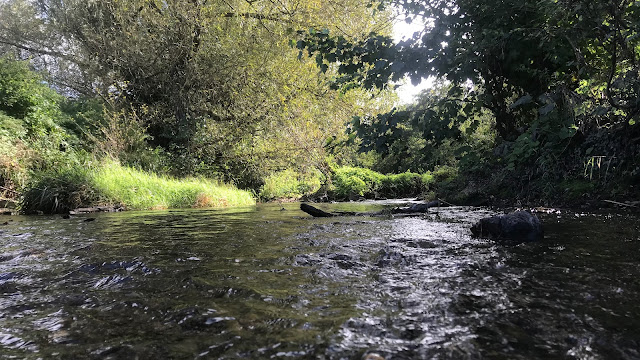For this short morning session down at the tiny river Alne it was out with the Salmo Cockchafer. This little floating lure shallow dives on the retrieve and moves in a quite enticing fashion.
The last visit here I fished the shallower swims and caught a few wild brown trout and also had some chub come up from the depths to look at the lure but then they returned as quickly as they arrived.
There are some deeper swims here even though the river is painfully low and clear in the main, there are still areas that hold fish because the change of depth over such a small distance really can be fairly dramatic indeed. Maybe something more 'natural' looking may well trip up the most cautious of all fishes.
It's a stretch of river that exhibits all the characteristics of a left left to its own devices, a natural river where nature is left alone to do its own thing, but then like every waterway there are some anomalies.
You see as I was walking up to the first swim a heron was disturbed but then I heard a rather large splash. I knew instantly what it was and managed to get a half decent picture on my phone of one of the resident otters.
I say otters as I've seen a far larger one here to be fair at a similar time. I watched it for a good while hunting and bubbling as they do and after it managed to catch a small fish it disappeared from view. Despite seeing me a couple of times it didn't seem to mind I was sharing the bank with it.
Cockchafers make an irritating buzz when flying, and the gigantic beetles are known for casusing irreparable damage to gardens and biting humans. They are mostly extinct across the rest of Europe due to the use of super-strength pesticides that are outlawed in the United Kingdom.
Although one of their common names is the May bug, if climate conditions are right, adult cockchafer beetles are often seen flying in April.
Cockchafers have whitish triangles on their sides, hairy bodies, reddish-brown wing cases that meet in the middle and orange fan-like antennae.
Adult cockchafers only live for about 5 or 6 weeks. During that time, they look for a mate and fly into the tree tops to feed on leaves. They fly at dusk on warm evenings, making a noisy hum, and are attracted to light.
They sometimes mistake chimney stacks for tree tops and occasionally fall down chimneys into open fireplaces, then after dark, they are attracted to light and can get caught in lamp shades.
Although they are known as bugs, cockchafers are not true bugs, which belong to another group of insects that includes shield bugs, water bugs, aphids and scale insects. True bugs that can fly have wings that usually overlap when folded, instead of meeting in a mid-line as cockchafer wings do.
Cockchafers spend most of their lives (three to four years) underground as larvae, or grubs. The grubs are white and C-shaped with six legs and reddish-brown heads.
They can be larger than the adults, growing to up to 4cm and are a food source for owls and bats. Grubs eat the roots of a variety of plants and in large numbers can become pests damaging pastures and crops.
It was turning in to a frustrating session because fish after fish seemed to attack the lure but then either tentatively grabbed it or swam up to it and then abruptly turned away.
Nothing of size to be fair but when you've standing high on the bank every fish take can be seen. Exciting stuff that a murky canal cannot offer the same visual appeal.
A change in lure was in order, back to a 3.5cm Salmo Rattlin Hornet which did the business last weekend and sure enough the fourth cast a decent Chub was on. The problem was I didn't get on top of the fish nearly quick enough and the Chub carted to my right and quickly in to some over hanging thick cover.
It wasn't hooked cleanly though so as quickly as it was hooked it was off, damn !!!. It looked a decent stamp too, probably greater than 3 pound I'd imagine.
I carried on in that swim without any other rises so moved down to the next one. Eventually after another couple of aborted takes the first fish was on. It gave a good account for itself but not the biggest of Chub that this stretch can offer. At least it was fish though and putting a line through the frustration of earlier.
In the end after losing the hot perch lure in a snag :( I managed another 3 fish which in the end turned in to a half decent session. I love roving these little rivers especially when the banks are so quiet and it's so handy to get here.
I'm hoping some rain would top it up though because I'm sure it would fish even better when there is a bit of water on. A small waist bag of bits, a rod and a landing net, you cannot get more simpler either.












Really enjoy the writings please keep posting
ReplyDelete